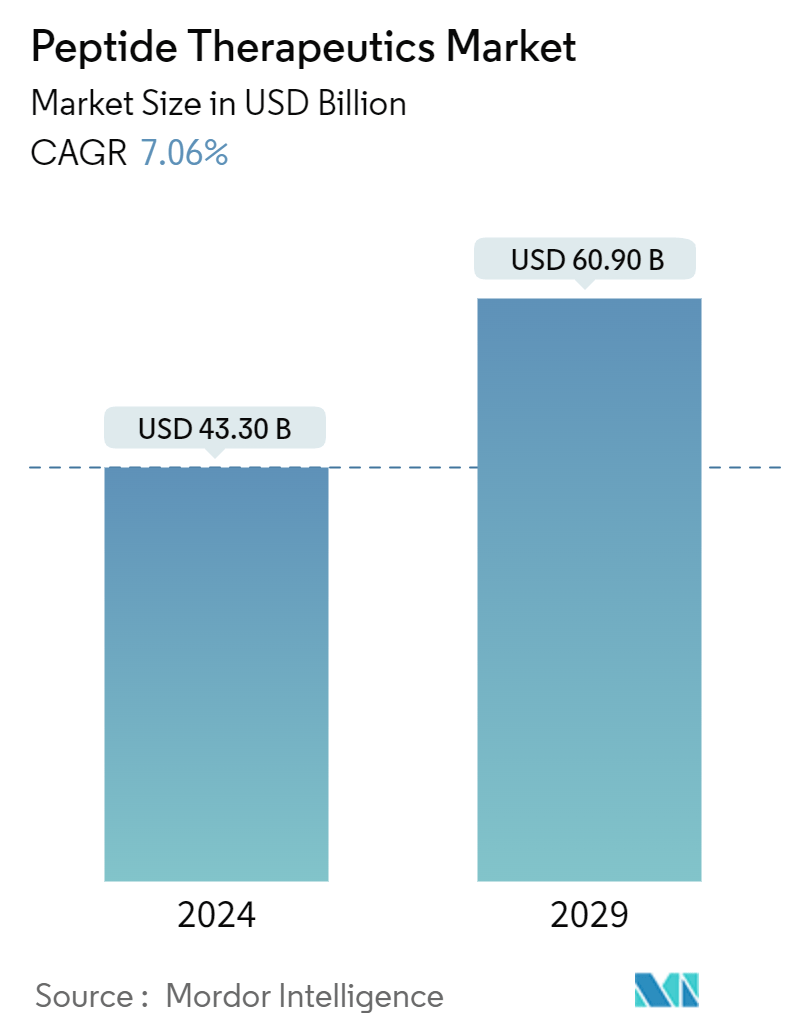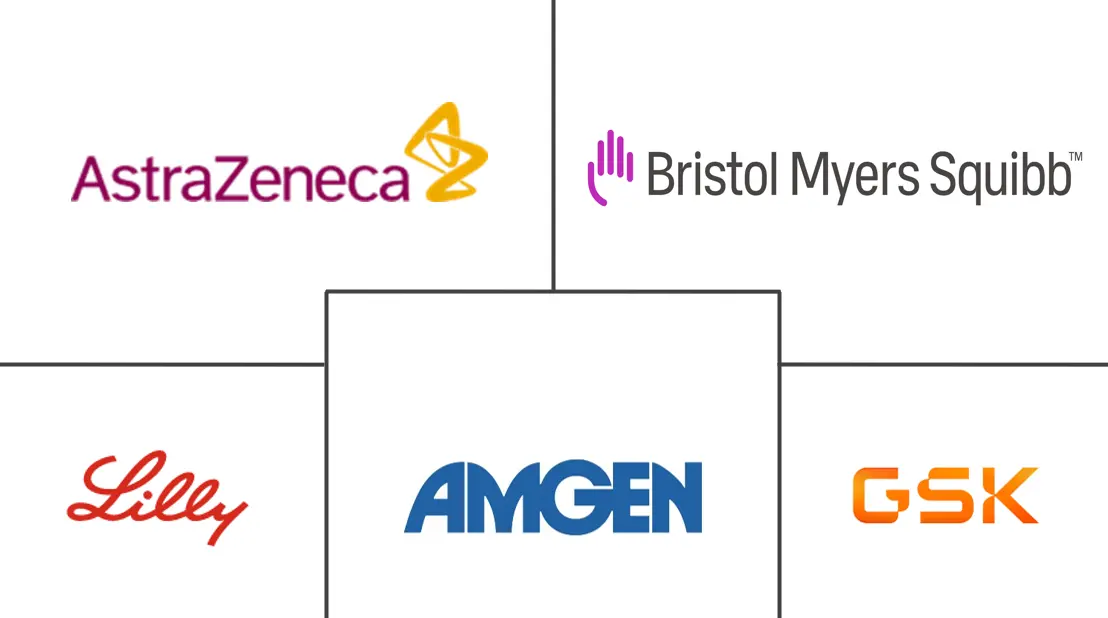Market Size of Peptide Therapeutics Industry

| Study Period | 2019 - 2029 |
| Market Size (2024) | USD 43.30 Billion |
| Market Size (2029) | USD 60.90 Billion |
| CAGR (2024 - 2029) | 7.06 % |
| Fastest Growing Market | Asia Pacific |
| Largest Market | North America |
Major Players
*Disclaimer: Major Players sorted in no particular order |
Need a report that reflects how COVID-19 has impacted this market and its growth?
Peptide Therapeutics Market Analysis
The Peptide Therapeutics Market size is estimated at USD 43.30 billion in 2024, and is expected to reach USD 60.90 billion by 2029, growing at a CAGR of 7.06% during the forecast period (2024-2029).
The COVID-19 pandemic substantially impacted the peptide therapeutics market. The pandemic surged the need for the development of novel peptides. In April 2022, an article published in the IJPRT journal reported the companies had developed peptide-based vaccines for COVID-19 treatment. Thus, initially, the growth of the peptide therapeutics market was driven by the increase in COVID-19 cases, as peptide therapeutics were reported efficacious for the treatment of Sars-CoV-2 infection. However, in the current scenario, as the pandemic has declined, the market may get negatively impacted. However, it is anticipated that with the efficacy of peptide therapeutics in treating other chronic diseases, the studied market will witness stable growth over the forecast period.
The major factors driving the market growth are the increasing prevalence of cancer and metabolic disorders, rising investments in research and development of novel drugs, and technological advancements in peptide therapeutics.
Cancer cases are increasing worldwide. Globocan 2020 reported that by 2040, cancer cases worldwide are expected to increase by 56.7% of the current cancer cases. Studies have reported the significant results of peptide therapeutics in cancer treatment. For instance, in February 2021, an article published in the journal SCB reported that new-generation peptide therapeutics target cancer-specific signatures. Hence, they hold enormous potential for cancer therapy and diagnosis. Therefore, the increasing number of cancer cases and the significant effect of peptide therapeutics in cancer treatment is driving the growth of the studied market.
Also, the rising prevalence of some metabolic disorders, such as genetic disorders, organ dysfunction, and mitochondrial dysfunction, is fueling the growth of the studied market. Gaucher disease (GD) is an autosomal recessive lysosomal storage disorder characterized by progressive glucocerebroside storage in macrophages, predominantly in bone, bone marrow, liver, and spleen. In July 2022, an article published in the journal JPHO asserted that the prevalence of GD in global birth was 1.5 cases per 100,000 live births. The overall global prevalence of GD was 0.9 cases per 100,000 inhabitants. The high prevalence of such metabolic disorders is fueling the demand for peptide therapeutics for treating metabolic disorders, thereby driving the growth of the studied market.
Furthermore, the technological development and introduction of new peptide therapeutics for treating chronic diseases like cancer are also fueling the growth of the studied market. In May 2021, ISSAR Pharmaceuticals decided to license out its peptide-based new NCEs with pre-IND filing and the United States patent for various unmet healthcare needs of the population, making it affordable and accessible for better health outcomes. Such developments are driving the growth of the studied market.
Therefore, the studied market is expected to witness significant growth over the forecast period due to the increasing prevalence of cancer and metabolic disorders, rising investments in research and development of novel drugs, and technological advancements. However, instability issues of peptide therapeutics, the high cost of developing drugs, and stringent regulatory requirements for drug approval are expected to restrain the market growth.
Peptide Therapeutics Industry Segmentation
Peptides are short chains of amino acid monomers linked by peptide bonds. Peptides are distinguished from proteins based on size and, as a benchmark, can be understood to contain approximately 50 amino acids or less.
The Peptide Therapeutics Market is Segmented by Marketing Type (Generic and Branded), Application (Gastrointestinal Disorders, Neurological Disorders, Metabolic Disorders, Cancer, and Other Applications), Route of Administration (Parenteral, Oral, and Other Routes of Administration), and Geography (North America, Europe, Asia-Pacific, Middle East and Africa, and South America). The market report also covers the estimated market sizes and trends for 17 different countries across major regions globally. The report offers the value (USD million) for all the above segments.
| By Marketing Type | |
| Generic | |
| Branded |
| By Application | |
| Gastrointestinal Disorders | |
| Neurological Disorders | |
| Metabolic Disorders | |
| Cancer | |
| Other Applications |
| By Route of Administration | |
| Parenteral | |
| Oral | |
| Other Routes of Administration |
| By Geography | ||||||||
| ||||||||
| ||||||||
| ||||||||
| ||||||||
|
Peptide Therapeutics Market Size Summary
The peptide therapeutics market is poised for significant growth over the forecast period, driven by the increasing prevalence of cancer and metabolic disorders, alongside rising investments in research and development. The market's expansion is supported by technological advancements that enhance the efficacy of peptide therapeutics in treating chronic diseases. Initially, the COVID-19 pandemic spurred growth as peptide-based vaccines were developed, but the market is now expected to stabilize as it continues to address other chronic conditions. The cancer segment, in particular, is anticipated to experience robust growth due to the high specificity and biocompatibility of peptide therapeutics, which are increasingly being used in targeted drug delivery for cancer treatment.
North America is expected to dominate the peptide therapeutics market, fueled by heightened awareness of peptide products, a burgeoning biotechnology industry, and a high incidence of chronic diseases such as cancer and diabetes. The region's growth is further supported by government initiatives promoting the use of biosimilar drugs. The market is highly competitive, with major players like Eli Lilly and Company, Amgen Inc., and Pfizer Inc. leading the charge. These companies are actively involved in developing innovative therapies, as evidenced by recent advancements such as Enterome's immunomodulatory drugs and Sartorius's acquisition of Albumedix Ltd. These developments underscore the dynamic nature of the market and its potential for continued expansion.
Peptide Therapeutics Market Size - Table of Contents
-
1. MARKET DYNAMICS
-
1.1 Market Overview
-
1.2 Market Drivers
-
1.2.1 Increasing Prevalence of Cancer and Metabolic Disorders
-
1.2.2 Rising Investments in Research and Development of Novel Drugs
-
1.2.3 Technological Advancements
-
-
1.3 Market Restraints
-
1.3.1 Instability of Peptides
-
1.3.2 High Cost of Developing Drugs and Stringent Regulatory Requirements for Drug Approval
-
-
1.4 Industry Attractiveness - Porter's Five Forces Analysis
-
1.4.1 Threat of New Entrants
-
1.4.2 Bargaining Power of Buyers
-
1.4.3 Bargaining Power of Suppliers
-
1.4.4 Threat of Substitute Products
-
1.4.5 Intensity of Competitive Rivalry
-
-
-
2. MARKET SEGMENTATION (Market Size by Value - USD Million)
-
2.1 By Marketing Type
-
2.1.1 Generic
-
2.1.2 Branded
-
-
2.2 By Application
-
2.2.1 Gastrointestinal Disorders
-
2.2.2 Neurological Disorders
-
2.2.3 Metabolic Disorders
-
2.2.4 Cancer
-
2.2.5 Other Applications
-
-
2.3 By Route of Administration
-
2.3.1 Parenteral
-
2.3.2 Oral
-
2.3.3 Other Routes of Administration
-
-
2.4 By Geography
-
2.4.1 North America
-
2.4.1.1 United States
-
2.4.1.2 Canada
-
2.4.1.3 Mexico
-
-
2.4.2 Europe
-
2.4.2.1 Germany
-
2.4.2.2 United Kingdom
-
2.4.2.3 France
-
2.4.2.4 Italy
-
2.4.2.5 Spain
-
2.4.2.6 Rest of Europe
-
-
2.4.3 Asia-Pacific
-
2.4.3.1 China
-
2.4.3.2 Japan
-
2.4.3.3 India
-
2.4.3.4 Australia
-
2.4.3.5 South Korea
-
2.4.3.6 Rest of Asia-Pacific
-
-
2.4.4 Middle East and Africa
-
2.4.4.1 GCC
-
2.4.4.2 South Africa
-
2.4.4.3 Rest of Middle East and Africa
-
-
2.4.5 South America
-
2.4.5.1 Brazil
-
2.4.5.2 Argentina
-
2.4.5.3 Rest of South America
-
-
-
Peptide Therapeutics Market Size FAQs
How big is the Peptide Therapeutics Market?
The Peptide Therapeutics Market size is expected to reach USD 43.30 billion in 2024 and grow at a CAGR of 7.06% to reach USD 60.90 billion by 2029.
What is the current Peptide Therapeutics Market size?
In 2024, the Peptide Therapeutics Market size is expected to reach USD 43.30 billion.

